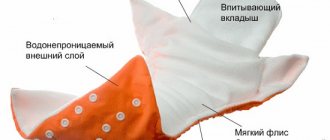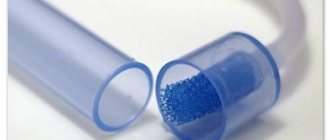Urinal: what is it and why is it needed?
This is a special polyethylene elastic container, the use of which helps to collect urine from a newborn. This is a sterile, pleasant to the touch and quite convenient device that greatly simplifies urine collection:
- Mom doesn't have to wait and catch the moment when the baby pees.
- Correct use of such a urine collection ultimately guarantees a reliable result, due to the fact that the urine goes directly into a sterile container.
- This device has a low price and is available to everyone.
- It is convenient and easy to use.
Features and use of urinals
Today there are many types of urinals, relevant in different situations. Such situations include:
- Urinary incontinence (uncontrolled urination);
- Postoperative period;
- Inability to move independently;
- Long-term catheterization;
- Removal of the bladder and subsequent ureterocutaneostomy;
- Acute cystitis accompanied by urinary incontinence;
- Other diseases of the genitourinary system;
In the question of how to use a urine bag, the main role is played by what device you use. They may differ in a number of ways. First of all, there are disposable and reusable urinals. Devices for single use are not intended for sterilization and are disposed of immediately after use. They also have a design that makes reuse impractical.
A regular reusable urinal is made from a material that can be sterilized, usually metal, glass, or plastic. Most often, these devices are bedside and are used in hospitals.
There are urinals with repeated intake of urine from one patient and subsequent removal; they are called individual reusable ones. They are usually made of latex and other polymers.
You can select devices:
- Drained - have a drainage hole for emptying;
- Undrainable - must be disconnected from the catheter each time it becomes full.
Male and female urinals are basically the same. Differences associated with anatomical and physiological characteristics have only catheters that are in direct contact with the patient’s urinary tract.
Separately, children's devices can be distinguished. Most often they are used when the doctor has prescribed a urine test for the baby. Bags for collecting urine in newborns are universal and can be purchased at any pharmacy.
Design and characteristics
- By design, it is a plastic bag that can hold a certain amount of liquid inside. There is a marking on the bag itself, the maximum mark is 100 ml.
- It has a hole for the genitals, which can be universal (has an oval shape and is suitable for use by all children) or separately for boys (the hole is ovoid and pointed at the bottom), or for girls (there are small branches at the bottom and sides of the hole).
- There is a special strip around the perimeter of the hole that is glued to the newborn’s skin. When properly glued, urine enters the container, which is then easily removed from the skin, without causing any inconvenience or discomfort to the baby.
Preparing for urine collection
Before putting a urine bag on a baby, regardless of whether it is a boy or a girl, and using it, you need to wash the external genitalia with baby soap and dry with a clean towel. Boys don't need to open anything, just wash everything on top well.
This procedure is necessary to prevent various bacteria and microorganisms from getting into the urine, the presence of which may give an unreliable result and the analysis will have to be retaken again. Therefore, it is very important to properly prepare before using a urine bag and perform the procedure described above for the newborn.
How to collect urine from a little boy under one year old?
To collect biological material, you must perform the following steps:
- After tearing the packaging, take out the urine bag.
- Remove the protective layer of paper from the sticky surface.
- How to put a urine bag on a baby boy? To do this, you need to put the child on his back and spread his legs. The bottom of the adhesive rim should be between the anus and the penis. Place the penis and scrotum inside the hole, and press the adhesive layer, starting from the bottom, to the skin of the perineum. You can put only the penis into the hole, and glue the bottom adhesive layer to the scrotum.
- All we have to do is wait for the result. To speed up the process of urination, the child is given water to drink or breastfed, the lower abdomen is massaged, or the water tap is opened. After filling the reservoir, carefully unfasten it.
- Next, you need to cut off one of the corners of the urinal and pour the volume of contents, which is determined according to the existing scale, into a sterile plastic jar purchased at the pharmacy.
- Wash the child to remove any remaining glue.
The collected urine must be taken to the laboratory for testing within 2-3 hours. Using the device is not difficult - you can look at the photo on how to properly put on a urine bag for a boy.
How to use a urine collector
- First, you need to prepare your newborn as described above and wash your hands with soap. Any analysis must be carried out in the utmost purity. Some even suggest that mothers use sterile gloves when putting the pouch on their newborn.
- Now open the package, take it out, straighten it and remove the protective layer from the Velcro that is attached to the child’s skin.
- For a girl it needs to be attached over the labia, and for a boy so that the genital organ and testicles completely fit into it. It is very important to glue this device correctly, otherwise the urine will simply leak out. It’s better to stock up on not one, but several collections. If you fail to put it on correctly the first time, you will have the opportunity to use a new container and carry out the collection correctly. Indeed, the main difficulty that almost all parents encounter when using a urine bag for the first time is the ability to correctly attach the bag. And in most cases, the first gluing is unsuccessful, so it’s worth stocking up on such devices.
- After you put on the device, it is advisable to swaddle the baby or put on, for example, panties or a diaper, so that nothing moves. The child is constantly on the move and can easily remove the Velcro.
- As soon as the baby pees, the container needs to be peeled off, the place where it was glued should be rinsed with clean water, wiped with a towel and lubricated with baby cream. It is advisable not to leave glue residue on the skin so that the baby does not develop allergies.
- Make a cut at the bottom of the bag and pour the contents into a sterile container. It is necessary to pour it, because the laboratory will not accept the material for analysis if it is in this form.
If the material cannot be collected within an hour, further use of the urine bag is unacceptable, so it must be removed and a new one attached, otherwise the analysis results may be unreliable.
Features of collecting and passing urine tests in newborns
When taking a urine test, you need to consider the following points:
- Only the morning portion is used for the study;
- Do not use urine collected in a pot or squeezed from diapers;
- the collected biomaterial must be transported in a sterile, hermetically sealed container purchased from a pharmacy;
- for delivery to the laboratory, no more than three hours should pass from the moment of urine collection.
To facilitate the urine collection procedure, it is best to use a urine bag purchased from a pharmacy chain. Buy at least a couple of products at once in case one of them fails. Remember that the urine bag can only be used once; repeated use will compromise sterility and result in distorted test results. And you already know how to put on a child’s urine bag for a boy.
Helpful information
After childbirth, almost every woman experiences stretch marks. Some even develop hemorrhoids after childbirth and the question involuntarily arises: what to do about it? For some mothers, the question of how to lose weight after childbirth or what to do with diastasis becomes relevant. This information may be useful to you, so you can easily access it on our website.
How did you handle the difficult task of collecting urine from your newborn baby? Have you used such a device for these purposes? We will be glad if you leave your reviews about the urinal for infants and possible useful tips in the comments. And also do not forget to leave your feedback on the article you read.
Types of urinals
For patients in different clinical conditions, different types of urinals are provided. Depending on whether the patient can move or not, a bedside or wearable (foot) version is used.
Bedside urinals are used both in medical institutions and at home. They are used for bedridden patients who, due to health conditions, are not able to walk to the toilet on their own, as well as at night for patients with urinary incontinence. The device is fixed on the bed and structurally consists of an adapter, a bag for collecting liquid, a valve and an outlet tube. It’s easy to figure out how to collect urine in such a urine bag. There is a scale on the bag that shows how full the device is.
Foot wearable urine receivers. Used for patients with urinary incontinence who can move independently. A urine collection bag, as a rule, has a smaller volume than a bedside bag. Modern devices are convenient, can be invisible under clothing and create almost no discomfort when walking. You can either glue the urinal bag with Velcro or attach it using special fasteners with an elastic band to the lower limb. The devices allow the patient to feel comfortable and have a special non-return valve that prevents leakage even when the bag is tilted 180 degrees. The tube is soft and at the same time resistant to kinks.
Urinals in the NOVAMED catalog
Buy









